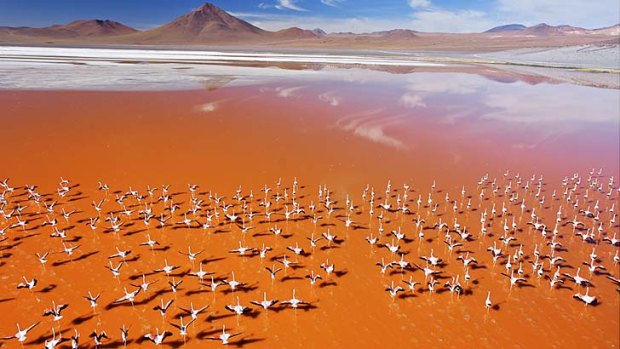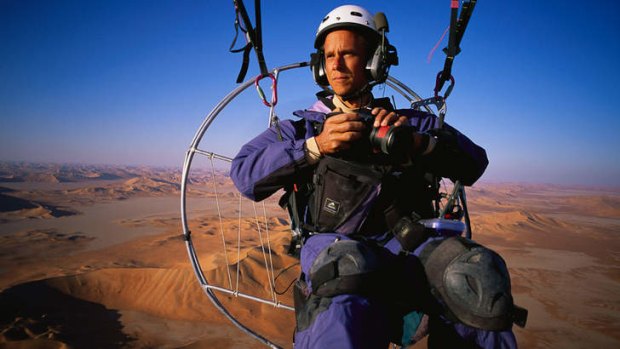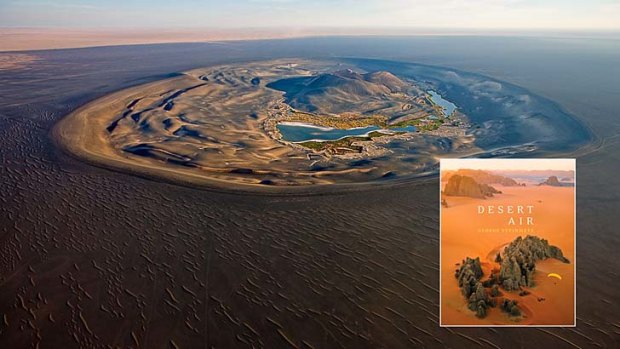This was published 11 years ago
World's most extreme deserts captured in stunning shots
By Jane Reddy

Aerial views of Laguna Colorada, which is red due to natural hot springs which provide nutrients for red algae to bloom, from George Steinmetz's book Desert Air.
Camera's eye in the sky
George Steinmetz's mission to photograph the world's extreme deserts from the air has been a 15-year, 27-country (plus Antarctica) odyssey.
Flying with a motorised paraglider, images of Tigrean and Afari men prying salt from the dry section of Lake Assale in Ethiopia to the mega dunes of Dasht-e Lut, Iran, are recorded in his book, Desert Air.

Photographer George Steinmetz taking a self-portrait with a camera attached to his foot.
It's the bold means of transport, and at 32 kilograms the lightest powered aircraft in the world, that has allowed Steinmetz to enter remote areas; a basketball court area is space enough for take-off or landing and he has launched at elevations of 4400 metres to 423 metres below sea level.
Flying at 48 kilometres an hour, Steinmetz says the paraglider, which is "like a lawn chair", gives unimpeded views horizontally and vertically. "It's also relatively quiet in flight, like a moped, and it lets me fly low and slow over the ground with minimum disturbance to people and animals below," Steinmetz says.
Steinmetz has had his share of mishaps along the way. He was arrested in Iran as a suspected spy and crashed into a tree in western China. Desert Air ($US60, Abrams).

Volcanic crater of Wau al Namus, (Wau means hole, so Wau al Namus is hole of mosquitos), This massive (and apparently dormant) volcano can be easily be seen in satellite views of Southern Libya, as a large black smear in the wind-scoured sands of the Sahara. From George Steinmetz's book Desert Air (inset).
See georgesteinmetz.com.
Horrible histories of war
London's Imperial War Museum at South Bank reopens in July and with it a new family exhibition, Horrible Histories: Spies and Secret War, based on the children's book series by Terry Deary.
World War II spycraft, including codes, camouflage and forgeries will be a feature as the series celebrates its 20th anniversary this year.
The redevelopment of the museum has started with the World War I galleries, and more of this collection will be on display. The museum is one of five around England dedicated to a record of operations in which Britain or the Commonwealth have been involved since 1914.
Also on South Bank, Sea Life London Aquarium has introduced 16 new sharks and access to backstage areas normally closed to the public and, from a capsule in the London Eye, visitors can enjoy a guided tour of their surrounds.
See iwm.org.uk.
Secrets of the ship
Extracurricular activities on board luxury liners Queen Mary 2, Queen Elizabeth and Queen Victoria are no longer confined to leisurely pursuits such as acting and dance classes, with new behind-the-scenes tours.
The 3½-hour tour looks at how these behemoths run seamlessly, and includes stops at the bridge for a meeting with the captain; "Burma Road", the crew passageway that runs the length of the ships; and theatres with more than 3000 costumes for a lesson in stage lighting and sound.
There is one tour, limited to 16 passengers, a sailing. It costs $US120 ($115) a person.
See cunardline.com.au.
Cruising to a record
It's not yet over, but February is set to be a bumper month for the cruise industry with a record 36 ships to drop anchor in Sydney Harbour, according to specialist cruise retailer Cruiseabout.
The company's general manager, Jarrod Pask, says that when the 2012-2013 season ends in April, there will have been a record 265 passenger cruise ship visits, 66 more than last season, including 11 ships on their maiden voyage. March arrivals include the five-star Island Sky and MS Marina.
See cruiseabout.com.au.
Beer and vodka
Glean cooking wisdom between vodka tastings from food doyenne Maggie Beer on a 14-day journey to Moscow, St Petersburg and Suzdal. Coinciding with the ballet and opera season, Beer will be present for a hands-on class at a cooking school, trips to produce markets and a backstage visit to the Bolshoi Theatre in the capital.
The tour starts in St Petersburg on October 18 and costs from $12,940 a person twin share.
See Russian Travel Centre, www.eetbtravel.com.
Under the canvas
Outdoor types eyeing a new site to pitch their tent should find it in the pages of Camping around Australia. More than 3000 campsites with 500 new listings are detailed in national parks, state forests, beaches, caravan parks and off highways.
While Homestead Creek (NSW), Buandik, Tidal River (Vitoria) and Gilhams Beach (Tasmania) are among the most popular, the publisher, until the end of March, is asking people to send an image of their favourite place for a top-10 list.
See facebook.com/exploreaustralia (Explore Australia, $44.95).
Send news to smarttraveller@fairfax.com.au.
Sign up for the Traveller newsletter
The latest travel news, tips and inspiration delivered to your inbox. Sign up now.